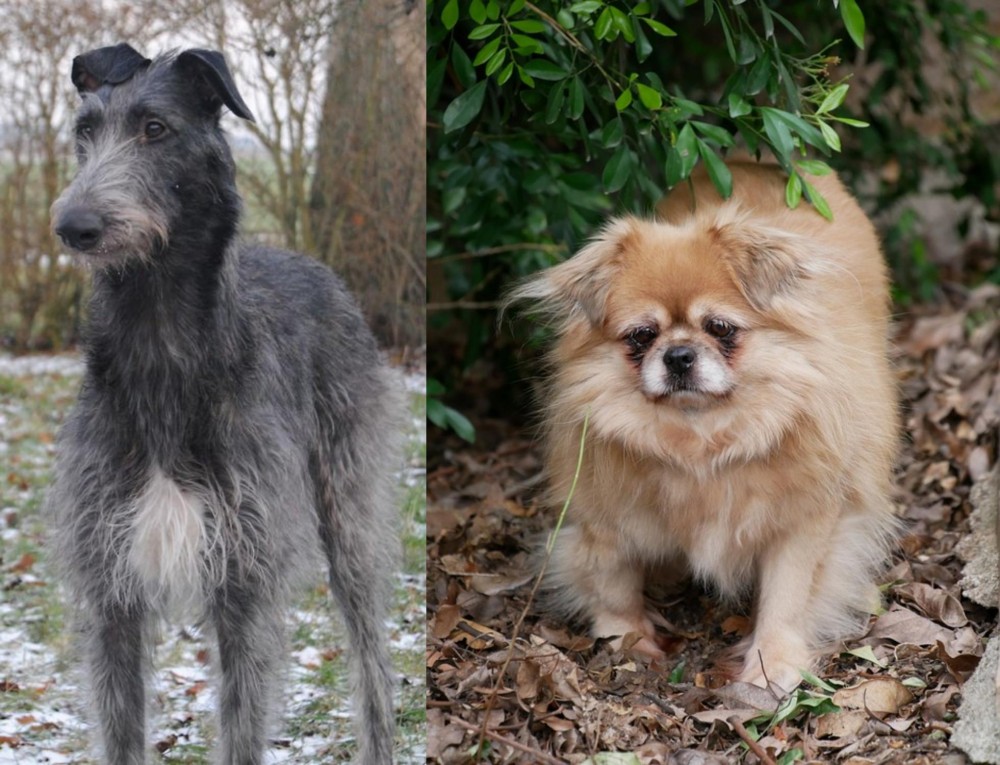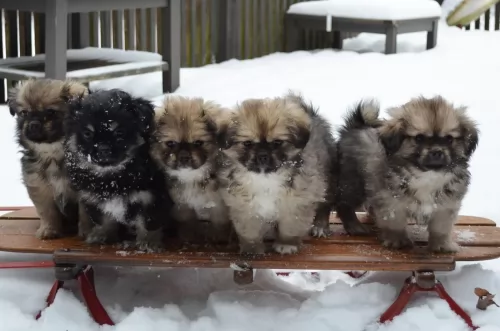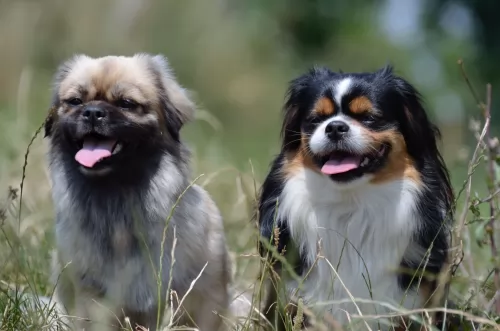 Petzlover
Petzlover Scottish Deerhound is originated from United Kingdom but Tibetan Spaniel is originated from China. Scottish Deerhound may grow 51 cm / 21 inches higher than Tibetan Spaniel. Scottish Deerhound may weigh 43 kg / 95 pounds more than Tibetan Spaniel. Scottish Deerhound may live 6 years less than Tibetan Spaniel. Scottish Deerhound may have more litter size than Tibetan Spaniel. Scottish Deerhound requires Low Maintenance. But Tibetan Spaniel requires Moderate Maintenance
Scottish Deerhound is originated from United Kingdom but Tibetan Spaniel is originated from China. Scottish Deerhound may grow 51 cm / 21 inches higher than Tibetan Spaniel. Scottish Deerhound may weigh 43 kg / 95 pounds more than Tibetan Spaniel. Scottish Deerhound may live 6 years less than Tibetan Spaniel. Scottish Deerhound may have more litter size than Tibetan Spaniel. Scottish Deerhound requires Low Maintenance. But Tibetan Spaniel requires Moderate Maintenance
 The Scottish Deerhound is considered the Royal Dog of Scotland. It is a sighthound that is large and bred to hunt large Red Deer. They are similar in appearance to the Greyhound, but they are bigger and heavier. Closely related to the Irish Wolfhound, they were used in creating it. The Scottish Deerhound is an ancient breed that is now very rare. It can trace its lineage to the 16th and 17th centuries.
The Scottish Deerhound is considered the Royal Dog of Scotland. It is a sighthound that is large and bred to hunt large Red Deer. They are similar in appearance to the Greyhound, but they are bigger and heavier. Closely related to the Irish Wolfhound, they were used in creating it. The Scottish Deerhound is an ancient breed that is now very rare. It can trace its lineage to the 16th and 17th centuries.
The Deerhound was a favorite of hunting nobility and could not be kept by any person or household that did not have at least the rank of earl. Despite this history the Scottish Deerhound was not considered separate from the Highland Greyhound and other staghounds until the 19th century. They were bred to stalk or “course” the red deer and were used extensively for this purpose until the beginning of the 20th century. At that time there was a need for smaller, slower deer tracking dogs.
At the start of the 20th century, the land for deer hunting had grown smaller and so had the deer. Also, the invention of the rifle made the fast Deerhounds who could cover large tracks of ground in minutes, no longer a necessity for successful hunting. As the clan systems fell and the nobility rose, the Deerhounds became the dog for nobility and landowners. There were a few non-nobilities who also kept them and hunted with them. As they were less needed for hunting a few households kept them as show dogs.
In the United States and Canada, both the Scottish Deerhound and the Greyhound were used for hunting wolves and deer. In Australia, the Kangaroo Dog – a deerhound crossbreed, and Deerhounds were used to hunt wild boar, emu and kangaroos. The Deerhound is one of the oldest of the breeds that are Greyhound-like. The Deerhound is not as fast as the Greyhound if they are running on a smooth surface. Get them on a rough surface and the will out that Greyhound. They appear to be larger and rougher than they really are. This gives them an advantage over the lighter, smaller Greyhound.
The Deerhound was a contributor to development of the Irish Wolfhound toward the end of the 19th century.
 Known fondly as the Tibbie and being referred to as little lions’, the Tibetan Spaniel is an ancient dog breed.
Known fondly as the Tibbie and being referred to as little lions’, the Tibetan Spaniel is an ancient dog breed.
They appear in ancient art dating way back to 1100BC. This tells you that this small dog has been around for a jolly long time.
When you look at him, you can see that his predecessors were the Pekingese and the Lhaso Apso. It’s odd actually that he is called spaniel, as he doesn’t look like a spaniel at all and he has certainly never been a gun dog. He is more of a companion breed.
Even today, you’ll find these dogs living with monks in monasteries. The American Kennel Club recognized the breed in 1984.
 The Scottish Deerhound looks a lot like the Greyhound, except it is heavily boned and larger in size. The Deerhound is also different in several other ways. Instead of the Greyhound, the Scottish Deerhound is more closely related to the Irish Wolfhound than the Deerhound. The Deerhound is a large, rough coated breed. It is a very tall breed; in fact, it is the tallest of all sighthounds.
The Scottish Deerhound looks a lot like the Greyhound, except it is heavily boned and larger in size. The Deerhound is also different in several other ways. Instead of the Greyhound, the Scottish Deerhound is more closely related to the Irish Wolfhound than the Deerhound. The Deerhound is a large, rough coated breed. It is a very tall breed; in fact, it is the tallest of all sighthounds.
The Deerhound has a long head with a flat skull and a muzzle that tapers at the end. They have dark eyes and a scissor bite with a tail that can be either curved or straight. The hair on their tails almost touches the ground. The rest of its coat is wiry and harsh with a beard, mustache and mane. The ears are soft and can be either held semi erect or folded against their head. Their coat is gray or grey-blue today but in the past, it might have been brindle, red fawn or yellow.
 Weighing between 4 to 7kg and standing at 23 to 30cm, the silky, double coat is fairly long and it sheds throughout the year.
Weighing between 4 to 7kg and standing at 23 to 30cm, the silky, double coat is fairly long and it sheds throughout the year.
The coat can be any color really, from tan to cream to brown and black and even a mix of colors.
The eyes are dark brown, the ears medium length and feathery and the tail is long and feathery too. The nose is fairly short and blunt.
The Tibetan spaniel is a small, active dog breed but not known to be shy or timid. He is an assertive dog, and intelligent too.
He would be better off having training and socialization as he is strong willed, stubborn and independent. He is loving, sweet and devoted to his owners.
He makes a good watchdog dog and will adapt well to life in the city or in the countryside. He can be both social and aloof, enjoying having his human family around him even though he may not be interacting with them.
He is playful and gets on well with children in the home as well as with other pets. He makes an excellent pet for older people too – he just needs to get his regular exercise.
 The Tibetan Spaniel dog is energetic and active, but doesn't require a lot of exercise. This makes him suitable for life in the city as well as the countryside.
The Tibetan Spaniel dog is energetic and active, but doesn't require a lot of exercise. This makes him suitable for life in the city as well as the countryside.
They’re social dogs and will relish any interaction with their human family. Give him the love and care he deserves and you’ll be rewarded with a loyal, loving friend.
 The Scottish Deerhound does face some serious challenges on the health front. These include:
The Scottish Deerhound does face some serious challenges on the health front. These include:
• Cystinuria – recessive disorder that causes an inability for cystine to be filtered from the urine.
• Gastric Dilatation Volvulus – otherwise known as bloat and it can be life threatening if not treated quickly.
 Tibetan Spaniels are generally healthy, especially if you provide them with good food and exercise.
Tibetan Spaniels are generally healthy, especially if you provide them with good food and exercise.
Whenever you’re looking to buy a puppy, make sure that you do research on where the puppy comes from. You don’t want to bring your puppy home and find that you’re faced with a host of health problems.
This eye problem effects photoreceptor cells which deteriorate over time and ultimately lead to blindness. It is an inherited disease that occurs in quite a few different breeds of dogs.
Dogs with this disease should never be bred. It isn’t a painful condition but you usually notice it when your dog has night blindness. Day blindness also occurs and later on cataracts can develop too.
 1.Feeding the puppy – Feed a high quality large or x large puppy dogfood at least 3-4 times a day. Do not overfeed.
1.Feeding the puppy – Feed a high quality large or x large puppy dogfood at least 3-4 times a day. Do not overfeed.
2.Feeding the adult – Feed a high-quality adult large or x large dog food once or twice a day. Do not overfeed.
4. Games and Exercises – The Deerhound needs plenty of exercise in a safe place where they have plenty of room to run. A small yard or life on a leash are not enough for this energetic breed. Play fetch, course running, Like the Greyhound they will be couch potatoes if you let them but that will hurt their health. Lure Coursing or hare coursing are good. Coyote hunting. Find space where they can run for the joy of running. Never force them to run – like along a bicycle
 The Tibetan Spaniel isn’t fixated on games and exercise like some other dog breeds are, but even so he isn’t a couch potato either. He will certainly require some moderate exercise such as a good walk every day.
The Tibetan Spaniel isn’t fixated on games and exercise like some other dog breeds are, but even so he isn’t a couch potato either. He will certainly require some moderate exercise such as a good walk every day.
You canine friend relies on you to make good food choices for him. Just like human beings have to watch what they eat if they want to remain healthy, dogs can’t just eat anything.
Feeding him an inferior diet will allow sickness. Commercially manufactured dog foods should be chosen with care, and there is a lot of information on the packaging to guide you.
Getting enough minerals and vitamins is imperative for good health. You should also try to give him some simplistic home-made food, while steering clear of toxic foods that could give your pet a whole lot of digestive problems. These are things like chocolates, crisps, peanuts, grapes, onions and spicy, exotic foods.
Just stick to simple, nutritious foods such as boiled chicken, brown rice and vegetables.
• Tibetan Spaniels will benefit from early socialization and training because then they become obedient and well mannered to have around with you wherever you go.
• Get your pet to the vet when he’s sick. As it is, he will need vaccines against serious pet illnesses as a puppy.
• Provide general grooming – a brush twice a week, checking inside the ears for redness, checking the eyes and checking for any unusual lumps.